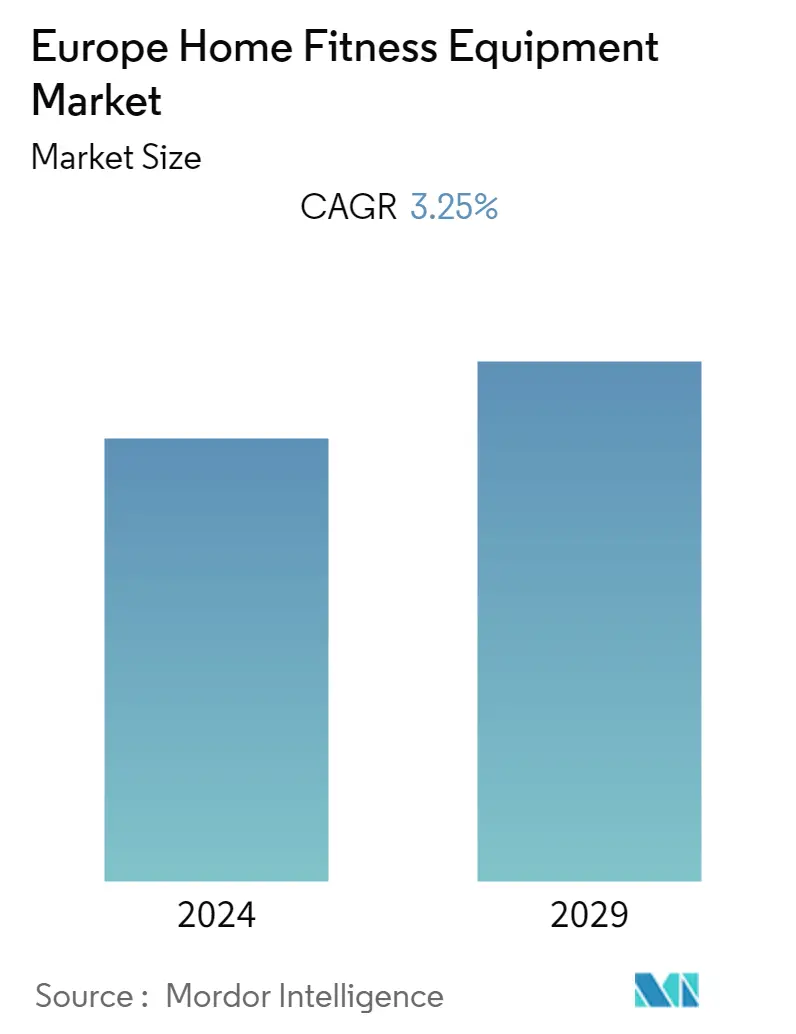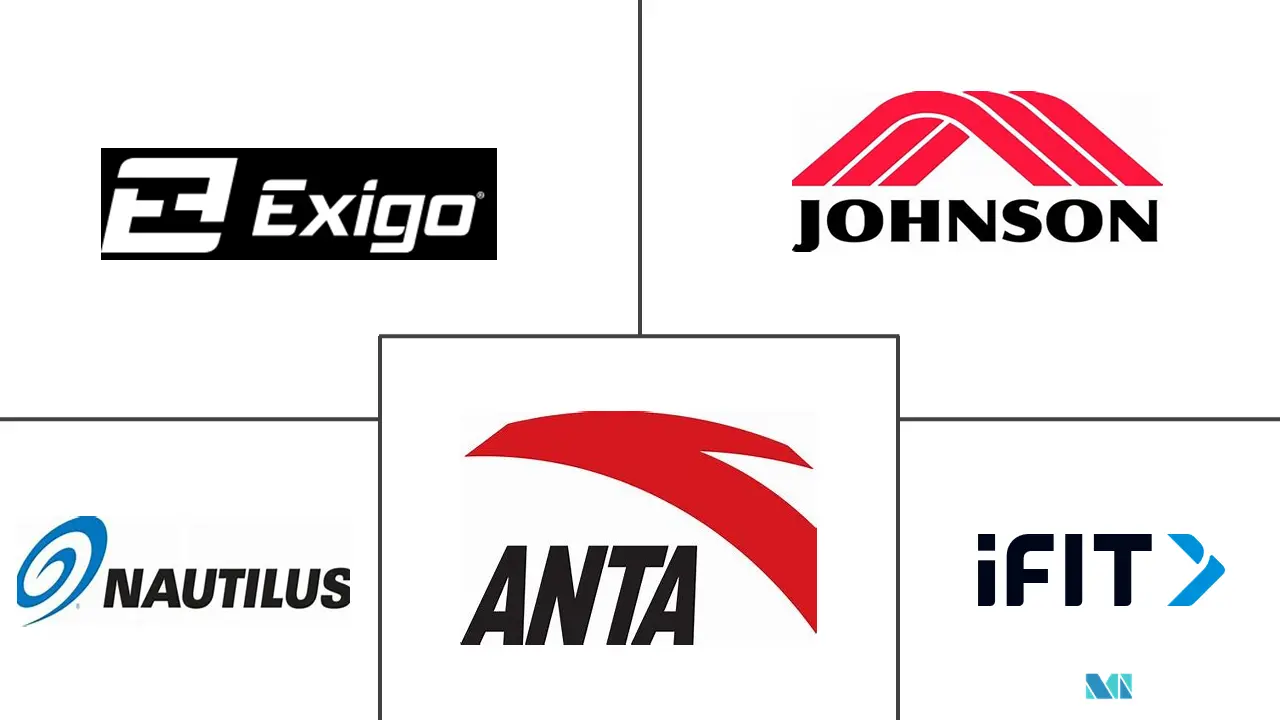Market Size of Europe Home Fitness Equipment Industry

| Study Period | 2018 - 2029 |
| Base Year For Estimation | 2023 |
| Forecast Data Period | 2024 - 2029 |
| Historical Data Period | 2018 - 2022 |
| CAGR | 3.25 % |
| Market Concentration | Low |
Major Players
*Disclaimer: Major Players sorted in no particular order |
Europe Home Fitness Equipment Market Analysis
Europe's Home Fitness Equipment Market is projected to register at a CAGR of 3.25% over the next five years.
Consumers in Europe are increasingly engaging in rigorous exercise that aid in weight control, immunity development, and an increase in stamina, consequently improving the overall health of the body. Precautionary healthcare coupled with increasing preference for customized workout regimes (including workout timings), eliminating obstacles like commuting, and a comfortable home-friendly environment is increasing the demand for home fitness equipment as customers are keen to exercise daily. In addition, the novel coronavirus outbreak drove demand for virtual fitness courses and mental health services in 2020, which boosted the sale of home exercise equipment and established a new trend that is still in use today. For instance, according to the price comparison site Idealo, between March and July 2020, sales of exercise bikes in the United Kingdom grew by over 2,113%. Home workouts are gaining traction post-covid, led by companies such as Peloton. Furthermore, increasing awareness and the rapid spread of online gym tutoring positively contribute to the market's growth.
Moreover, the increasing penetration of international and domestic equipment manufacturers and the consumer's preference for home fitness equipment are promoting the market growth. To sustain in this competitive market, key players are continuously introducing new gym equipment, taking innovative initiatives, and trying to differentiate in terms of price, functionality, size, weight, and post-sales services. For instance, in November 2021, Motive8 announced the debut of motive8 Refurb, a new website that sells various used and reconditioned gym equipment. They stated that their goal with the website is to sell used fitness equipment from top brands like Technogym, Wattbike, Octane Fitness, Concept2, Inc., Life Fitness UK, and more. Such initiatives and convenience factors are expected to drive the market's growth during the forecast period.
Europe Home Fitness Equipment Industry Segmentation
Fitness equipment products like training benches, treadmills, stationary bicycles, and dumbbell sets, among others bought to perform an exercise at home, are altogether called home fitness equipment. Europe's home fitness equipment market is segmented by product type, distribution channel, and geography. By product type, the market studied is segmented into treadmills, elliptical machines, stationary cycles, rowing machines, strength training equipment, and other product types. By distribution channel, the market studied is segmented into offline retail stores, online retail stores, and direct selling. By geography, the report provides a detailed regional analysis, which includes Spain, the United Kingdom, Germany, Italy, France, Russia, and the rest of Europe. For each segment, the market sizing and forecasts have been done based on value (in USD million).
| Product Type | |
| Treadmills | |
| Elliptical Machines | |
| Stationary Cycles | |
| Rowing Machines | |
| Strength Training Equipment | |
| Other Product Types |
| Distribution Channel | |
| Offline Retail Stores | |
| Online Retail Stores | |
| Direct Selling |
| Geography | |
| Spain | |
| United Kingdom | |
| France | |
| Germany | |
| Russia | |
| Italy | |
| Rest of Europe |
Europe Home Fitness Equipment Market Size Summary
The European home fitness equipment market is experiencing a notable expansion, driven by a growing consumer inclination towards home-based workouts. This shift is largely attributed to the increasing awareness of health benefits, such as weight control and stamina improvement, alongside the convenience of exercising at home. The COVID-19 pandemic significantly accelerated this trend, as lockdowns and social distancing measures prompted a surge in demand for home fitness equipment and virtual fitness solutions. Companies like Peloton have capitalized on this trend, offering innovative products and services that cater to the evolving preferences of consumers. The market is further bolstered by the penetration of both international and domestic equipment manufacturers, who are continuously introducing new and differentiated products to meet consumer demands.
In Germany, the home fitness equipment market is particularly promising, fueled by rising health concerns and a higher prevalence of obesity. The convenience and affordability of home workouts have led to a significant shift towards personal home gyms. The market is characterized by a competitive landscape, with major players such as Nautilus Inc., Johnson Health Tech Co., Ltd., and Anta Sports Products Limited actively engaging in product innovation and strategic partnerships to expand their reach. Online platforms have become a primary distribution channel, offering consumers easy access to a wide range of fitness equipment. As a result, the European home fitness equipment market is poised for continued growth, with lucrative opportunities for market players to capitalize on the increasing demand for home-based fitness solutions.
Europe Home Fitness Equipment Market Size - Table of Contents
-
1. MARKET DYNAMICS
-
1.1 Market Drivers
-
1.2 Market Restraints
-
1.3 Porter's Five Forces Analysis
-
1.3.1 Threat of New Entrants
-
1.3.2 Bargaining Power of Buyers/Consumers
-
1.3.3 Bargaining Power of Suppliers
-
1.3.4 Threat of Substitute Products
-
1.3.5 Intensity of Competitive Rivalry
-
-
-
2. MARKET SEGMENTATION
-
2.1 Product Type
-
2.1.1 Treadmills
-
2.1.2 Elliptical Machines
-
2.1.3 Stationary Cycles
-
2.1.4 Rowing Machines
-
2.1.5 Strength Training Equipment
-
2.1.6 Other Product Types
-
-
2.2 Distribution Channel
-
2.2.1 Offline Retail Stores
-
2.2.2 Online Retail Stores
-
2.2.3 Direct Selling
-
-
2.3 Geography
-
2.3.1 Spain
-
2.3.2 United Kingdom
-
2.3.3 France
-
2.3.4 Germany
-
2.3.5 Russia
-
2.3.6 Italy
-
2.3.7 Rest of Europe
-
-
Europe Home Fitness Equipment Market Size FAQs
What is the current Europe Home Fitness Equipment Market size?
The Europe Home Fitness Equipment Market is projected to register a CAGR of 3.25% during the forecast period (2024-2029)
Who are the key players in Europe Home Fitness Equipment Market?
Nautilus Inc., Johnson Health Tech Co., Ltd., Exigo, Ifit Health & Fitness Inc. and Anta Sports Products Limited are the major companies operating in the Europe Home Fitness Equipment Market.

